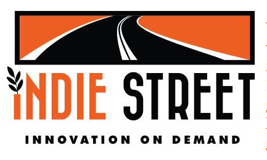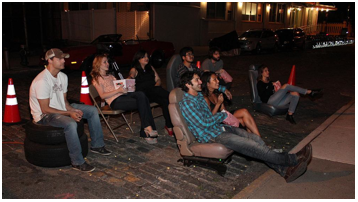By Jay Webb

Previously: Making A Film? Why?
Audience building interview 1
There is no such thing as art without audience. A motion picture does not even exist without its impact on human viewers. As an independent creator without established lines of distribution, how do you build an audience that yearns for your specific stories? How do you keep them excited about your stories of the future? In today’s market, your response to this question may be the difference between a “one & done” and having a long, sustainable career as a filmmaker.
 Rather than answer the question in hypotheticals, I will instead take look at a two 2014 films that have been particularly innovative in their building of a core audience. Hopefully from this others will be inspired to create their own authentic campaigns within their self distribution efforts.
Rather than answer the question in hypotheticals, I will instead take look at a two 2014 films that have been particularly innovative in their building of a core audience. Hopefully from this others will be inspired to create their own authentic campaigns within their self distribution efforts.
Ownership equals accountability
DIY distribution and marketing liberates a filmmaker from an evil third party who might mis-package their film, deliver it to the wrong audience, or even worse not give their seedling the attention it deserves. While this ownership sounds grand in theory, there are 2 catches: (1) there will be no-one else to point the finger at if your film fails and (2) you are going to have to do much more work. Yes, at IndieStreet we champion a group mentality and “do it together”(DIT) over “do it yourself”(DIY), but even on IndieStreet if your film release does not meet your expectations, there is really only one person that is held accountable. Your sisters and uncles and cousins in the Indie Street family will help as much as they can, but this is your baby.
The two IndieStreet partner filmmakers we will feature probably couldn’t be any more different individuals or have more distinct films. The first, “Cam Girlz” directed by Sean Dunne, tackles selling sex on the Internet and emerging forms of human connection. The next, “Tanzania: A journey Within” directed by Sylvia Caminer, documents an African voyage and the resulting personal and societal inner reflection. One of their crowd building campaigns was in the middle of production and the other was leading up to a limited theatrical release. The differences between these two documentaries and their directors only strengthens my encouraging argument:
No matter the stage of your career or the stage of your film, you have the ability to execute innovative & authentic strategies to build a sustainable audience.
Film 1: Cam Girlz Documentary (www.camgirlzdoc.com)
Director: Sean Dunne – (Oxyana, winner of Best new Doc filmmaker at Tribeca 2013)
Promotional Campaign: Crowdfunding campaign that doubled as an audience building promotion. Sean completed a $65,000 KickStarter campaign by partially targeting an untapped audience market.
Stage of film during campaign: in Production
1. So Sean, After deciding on your subject matter for Cam Girlz, did you take time to figure out the core audience for your film? If so, how did this help in these early stage promotional efforts?
The great mystery and challenge of being someone who makes films for an Internet audience is figuring out exactly who is watching your films. It’s really important for a director in my situation to understand their audience, so I can more effectively hone my message toward them during fundraising and marketing.
It’s not always going to be the case but with Cam Girlz we have a bit of a double edged sword in terms of audience – film lovers who have followed my work through the years and the built in viewership that the women we are documenting bring to the table – with very little overlap. The Kickstarter campaign was the perfect opportunity to bring those audiences together. One of the strategies that really helped was launching the campaign after we had a good portion of the film shot and had teasers and trailers in the bag. We needed to show both audiences how we were going to treat this subject matter, not just imply it. In the end that’s what led to the film being successfully funded.
2. This was your second successful KickStarter campaign. What can you share about your experience to date with crowdfunding (as a community growth tool)?
What we learned with the Kickstarter campaign for Oxyana was that it was about so much more than just raising money. The Kickstarter established a dialogue about the issues raised in the film and ultimately proved to be PR that we could have never otherwise afforded. Even if the dollars came up short, we were raising awareness about the social issue and attracting passionate supporters even before the film was made. That first campaign helped us identify our core audience and build a grassroots effort that led us to Tribeca, and eventually, to successful self-distribution.
Without traditional resources at our disposal all we can do is absorb and assimilate, so when it came time to fund Cam Girlz it was a no brainer to go back to Kickstarter. This time around we really understood the power of crowdfunding and what it meant for growing our audience.
3. The path for Cam Girlz is still unwritten, but can you discuss why you decided to jump into a self self distribution path with Oxyana so shortly after it won awards at the Tribeca film festival?
The idea of taking Oxyana on the film festival circuit for a year or more seemed unnecessary given where my audience comes from in the first place…the Internet. Rather than chase something that others said we were supposed to, we decided to trust ourselves and what we knew. We knew we had the means to self distribute and some good buzz coming off our success at Tribeca, and we knew that all of the initial deals that were put in front of us were bullshit. Putting our film into the machine would have only slowed the process of getting it to a wide audience. So we stayed small, focused, and in the moment. Eventually we had an epiphany of the obvious…that the film should be available to audiences while it still had all this momentum. And the decision paid off.
There are a lot of old guard ways of doing things that filmmakers blindly subscribe to when it comes to getting your work out there. We don’t have to be beholden to festival programmers or sales agents anymore. We need to take the opportunities in front of us, and not be afraid to start from scratch and make this more sustainable for ourselves. We have personally been lucky that Oxyana has been successful, but honestly, even if our means of distribution was an utter failure, I’d wear it as a badge of honor. I’d rather retain ownership and fail hard than buy into a system that never gave a fuck about me to begin with.
——————————————————————————————————–
Sean’s final statements should hit home for all filmmakers. Do not be afraid of failure or of what someone will say if a big studio does not pick up your picture. With current technologies, by branding yourself as a filmmaker or group of filmmakers, you can become your own studio machine. This is of course only if you put out quality content and focus on building your audience in authentic ways like Sean and his wonderful producer, Cass Greener, have done.
By tackling a unique subject matter, Sean and Cass have not only fed their craving for spelunking the caverns of human character, but they have also tapped into a whole new market. Probably half of the audience of Cam Girlz will be from the world of internet sex, not from the already saturated indie film community. In my opinion, at least a quarter of them will be so intrigued by the film’s non-boob storyline that they will start to follow the film’s director and his career. Easily thousands of viewers that probably have 0 interest in indie film, but now they have an interest in Sean Dunne. This new audience segment, on top of the fans from Oxyana, on top of the fans from IndieStreet and even this simple post will all roll Sean over into his next film and continue to grow his core audience even further.
Uncovering an untapped market segment isn’t easy, but if you are a great storyteller and you focus on strategic audience building at the early stages of your film…you can create a sustainable filmmaking career and gain some invaluable Indie street cred like my man Sean Dunne.
Jay Webb – Jay Webb is an independent film producer/writer and small business entrepreneur who has discovered through trial by fire that it is literally impossible for him to choose personal capitalism over passion. Always balancing a life on both sides of the tracks, he has discovered that helping good people succeed (success=happiness) is the core of what drives him. The IndieStreet direct & “group distribution” film initiative is his personal Autobahn.
Web: IndieStreet.com
Twitter: @indiest_films





